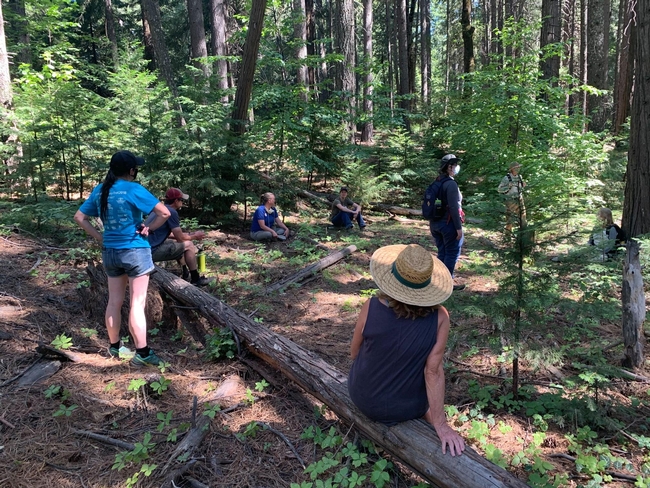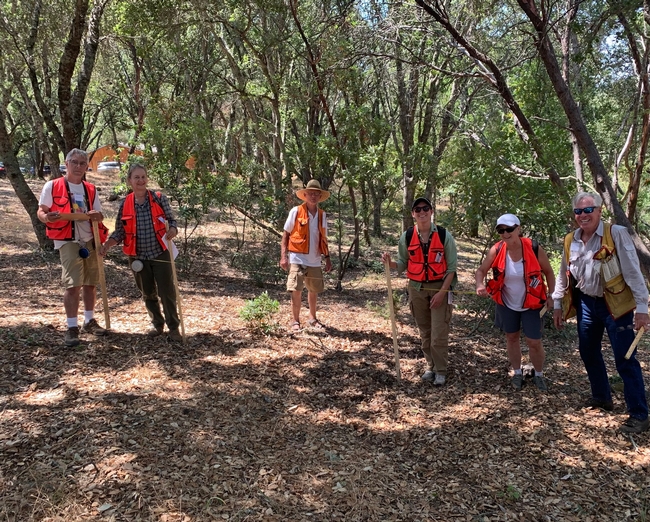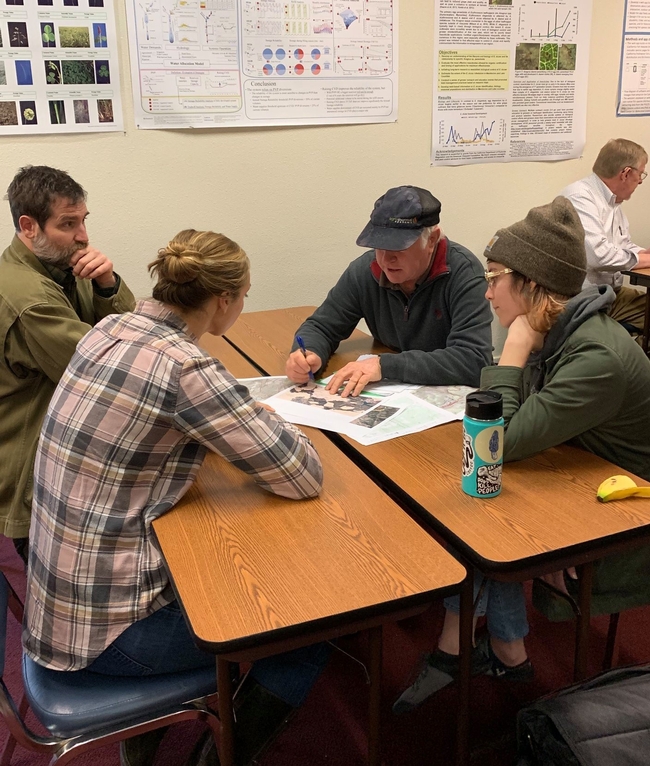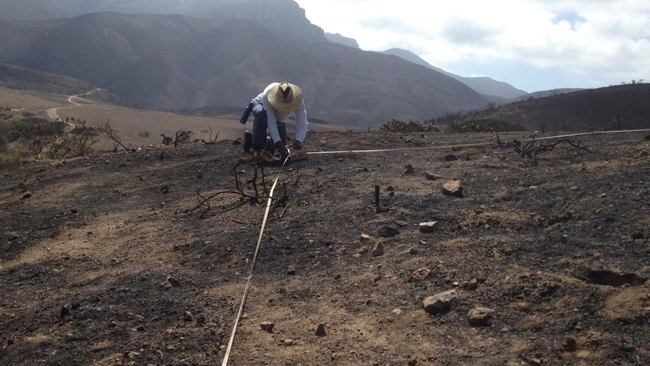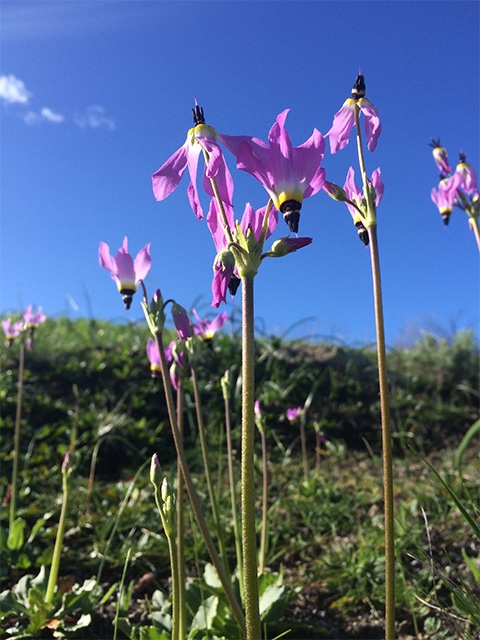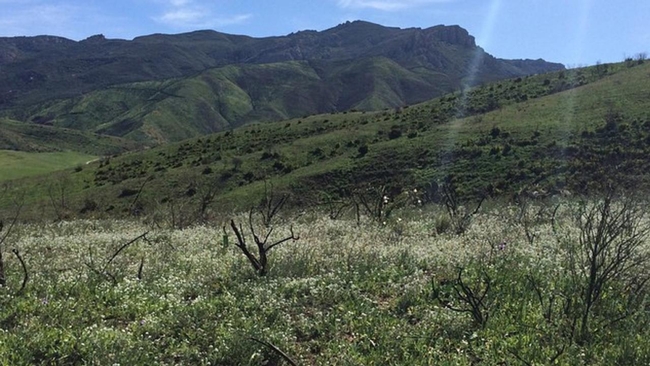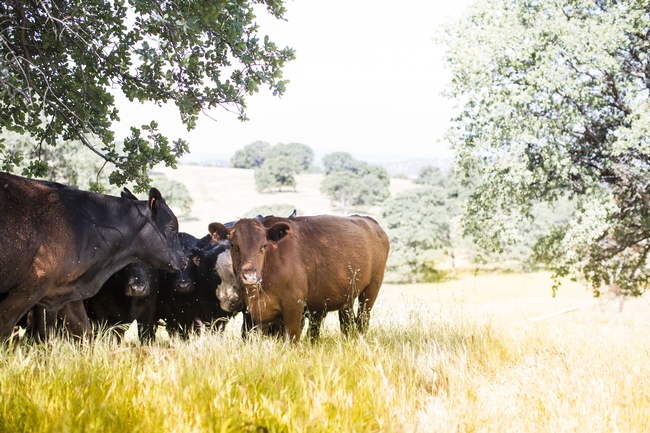Posts Tagged: Wildfire
Connecting California’s forest landowners with California Tree School
While trees and forests are often emblematic of constancy in a fast-paced world, our state's forests are actually changing before our eyes. Since 2020, the UC ANR Forest Stewardship Education (FSE) program has been helping California's forest landowners be proactive about the inevitable shifts their forestland will experience. The Forest Stewardship and Post-Fire Forest Resilience workshop programs use an online educational format, which guide landowners through the basics of creating forest management plans and managing post-fire landscapes, respectively. Now, the FSE team is piloting a new program to engage a wider audience of forest landowners and community members passionate about trees.
This spring, the Forest Stewardship and UC ANR Fire Network teams are holding the first California Tree School, where individuals attend multiple in-person classes on the forestry topics they are most curious about. “The existing online programs are very focused on forest management plans and post-fire activity, and [Tree School] lets us tackle other topics,” said UC ANR forest and natural resources advisor Susie Kocher.
A one-stop shop for continuing forestry education
California Tree School was inspired when Forest Stewardship Academic Coordinator Kim Ingram, Post-fire Academic Coordinator Katie Reidy and Kocher attended Oregon State University Extension's Tree School event in Clackamas County, Oregon. OSU Tree School is a day-long experience comprised of classes that cover the different dimensions of forestry: constructing a house from your own timber, carbon cap and trade, and buying portable sawmills are just a small sampling of the options for attendees. OSU Tree School students ranged from forest landowners to community college students, contributing to a space which would facilitate community connections as well as learning.
Kocher described the experience as a “a great one-day, one-stop shop to keep up-to-date on what we [forest landowners and professionals] should know.” Excited by the breadth of opportunities offered at OSU's Tree School, Ingram, Kocher and Reidy were inspired to bring the format to California.
“It's our time to discuss the whole ecosystem,” noted Reidy. “Tree School is bringing in the trustworthy, reliable group of experts who can provide more information on the questions pertaining to landowners' specific goals.”
California Tree School will be offered in two locations this spring, with CA Tree School- Hopland taking place on May 4, and CA Tree School- El Dorado on June 1. Similar to OSU's Tree School, attendees are expected to be a mix of forest landowners, natural resource professionals and interested community members.
Connecting statewide professionals; personalizing forestry education
Tree School offers attendees the opportunity to focus on subjects that pertain to their specific learning needs. This personalized approach is a new foray for the Forest Stewardship team, but is something that Ingram says workshop participants have been wanting for some time.
“Our participants never think they learn enough. They are always asking for more information, and this Tree School gives us the chance to expand on things we might not have had a chance to go over in the workshop series,” remarked Ingram. Additionally, Tree School instructors had creative freedom when it came to developing their classes, from the topic to the class format. This is evident when browsing through each session's class catalog. CA Tree School attendees choose four classes to attend, meaning they can build their first burn pile, understand the ins and outs of regional wildlife, paint outdoors and learn how to aid statewide reforestation efforts all in one day.
“I felt that Tree School created a sense of trust around complex topics,” noted Reidy about her experience last year in Oregon. For CA Tree School, the Forest Stewardship team aims to do the same. This meant recruiting from throughout the UC ANR network and other organizations, including CALFIRE and CARCD (California Association of Resource Conservation Districts), to bring trusted voices to the community.
“What's exciting about Tree School is that we are bringing natural resource professionals from all around to engage everyone at the same time, and all in one place,” noted Ingram.
The team is excited to see all the connections that will be made between community members and professionals during this pilot year, and “if this is successful and we can bring it back next year,” commented Kocher, “we are definitely interested in partnering with more people and expanding our outreach.”
Making CA Tree School an in-person experience was important to the team, as much of the education is hands-on. Additionally, Kocher sees enhanced potential for building personal connections: “In person, you have this opportunity for people to identify as part of a community,” noted Kocher, “So I'm excited for people to hang out with each other.”
Encouraging an informed community
“You can't separate the emotional from the physical, and there are a lot of topics in forestry like wildfire and economics that can be a bit of a downer,” said Ingram. “I'm excited to help create a positive learning environment, and one that encourages folks to turn to UC Cooperative Extension for these resources.”
“Our main goal here is to get science out there,” concurred Reidy. “The more exposure people have to science, the more confident they feel in themselves and their wants and needs.”
Car fumes, weeds pose double-whammy for fire-loving native plants
Wildflower displays threatened
Northwest of Los Angeles, springtime brings native wildflowers to bloom in the Santa Monica Mountains. These beauties provide food for insects, maintain healthy soil and filter water seeping into the ground – in addition to offering breathtaking displays of color.
They're also good at surviving after wildfire, having adapted to it through millennia. But new research shows wildflowers that usually would burst back after a blaze and a good rain are losing out to the long-standing, double threat of city smog and nonnative weeds.
A recent study led by Justin Valliere, assistant professor in the UC Davis Department of Plant Sciences, found that native wildflowers and other plants that typically flourish following a fire were, instead, replaced by invasive plants on land that received the kind of nitrogen contained in vehicle emissions.
“Many native plants in fire-prone areas rely on fire, and some are entirely dependent on it. Some are even most abundant after a fire,” said Valliere, a UC Cooperative Extension specialist in invasive weed and restoration ecology. “But we found that these fire-following species may be especially vulnerable to the combination of nitrogen pollution and invasive plants.”
That's part of the reason why native plants in these mountains have been declining.
Seeds – banked in the soil and waiting to sprout
The problem faced by native plants can be compared to a drawn-down bank account: Funds withdrawn are not being replaced.
It starts with fire, an important ecological process, Valliere said. Flames burn through plants on the surface and return their nutrients to the soil. Seeds sleeping in the ground wait for the next rain to sprout, then use those nutrients to grow.
“Plant diversity is often highest in growing seasons immediately after a site burns,” he said.
But invading plants have many advantages over native ones. They often sprout earlier, grow faster and create more seeds, all while tolerating drought.
“They're like cheaters,” Valliere said. “They don't follow the same rules.”
Nitrogen, too, is an important piece of every plant's nutrition. They all get a fertilizing boost from nitrogen that floats up in vehicle emissions and falls to the ground. But the invaders use nitrogen and other nutrients to grow faster, winning the race for water and sunlight. As a result, fewer native plants reach maturity, producing fewer seeds that keep their populations thriving.
When the bank balance reaches zero
The 2013 Springs Fire gave Valliere a unique opportunity to study the combined impacts of wildfire and extra nitrogen. He and colleagues from UC Riverside and the National Park Service created test plots in the Santa Monica Mountains where the fire had burned. Then, they added nitrogen to the soil to mimic the amount and type that LA's smog would deposit. Over the study's three years, native plants that typically would have flourished after wildfire instead declined even faster in the plots with added nitrogen.
Native seeds sprouted, but didn't flower. Over time, the soil's bank of seeds drew down.
“Each seed has one chance to flower and reproduce,” Valliere said. “If a seed grows and gets outcompeted, that seed has lost its chance to replenish the seed bank.”
Without the chance to replenish their bank account, native plants will die out, and the whole ecosystem will be thrown out of balance.
“There is inherent value in biodiversity,” Valliere said. “These invasive weeds could prevent the re-establishment of native shrubs after fire, sometimes forever altering the plant community.”
The loss of native plants can have cascading effects on the larger environment, he added. Problems can include the loss of native bees that feed on the flowers, and mudslides when rain makes hillsides unstable.
This problem is likely to repeat in similar areas where biodiversity is highest after wildfires – including parts of the Mediterranean basin, southern Africa and Australia. The addition of city smog “could have serious consequences for the biodiversity of fire-prone ecosystems worldwide,” Valliere warned.
Read the paper, “Nitrogen deposition suppresses ephemeral post-fire plant diversity,” by Justin Valliere, Irina Irvine and Edith Allen.
This article was first published on the UC Davis Department of Plant Sciences website.
New Film Profiles Immediate Actions to Restore California's Wildfire-vulnerable Forests
The new film "California's Watershed Healing" documents the huge benefits that result from restoring forests to healthier densities. UC Merced's Sierra Nevada Research Institute partnered with the nonprofit Chronicles Group to tell...
Wildfires Also Impact Aquatic Ecosystems
In devastating cases dotting the globe in recent years, climate warming has led to an increase in the number and severity of destructive wildfires. Climate change projections indicate that environmental and economic damage from wildfires will spread...
Fighting fire with feeding
Are cattle a secret weapon for taking on California wildfires?
California's cattle ranchers contribute a significant amount to the region's culture, economy and food supply, but do they also inadvertently help to temper the wildfires that have been plaguing the state? And if so, is it a better alternative – environmentally speaking – to letting grasslands burn?
A new study published in the journal Sustainability delves into the topic, weighing the advantages – and disadvantages – grazing cattle bring to the table. Researchers, including scientists from University of California, Davis and UC Agriculture and Natural Resources, set out to calculate the greenhouse gas emissions of cows consuming vegetation that would otherwise burn in wildfires. Then they estimated the GHG emissions that would result should that forage be untouched and therefore, consumed by fire, eventually comparing the two.
Feeling the burn
Given the severity of California's recent wildfires and the belief they will continue and even escalate in the near future, it's a discussion worth having, said Frank Mitloehner, an expert in animal agriculture and air quality from UC Davis, director of the CLEAR Center and one of the researchers who contributed to the peer-reviewed article.
“Each year from 2010 to 2020, California lost on average 89,000 acres of grassland to wildfires,” said Mitloehner, who is also a Cooperative Extension specialist. “In addition to the obvious disruption and devastation they caused, the fires spewed greenhouse gases and harmful particulate matter such as black carbon into the air and into our atmosphere. Those alone threaten climate health and human well-being.”
A fast and furious gas
Cattle are adept at eliminating herbaceous fuel as they graze. However, at the same time, their specialized digestive system produces methane that is expelled most often in the form of enteric emissions … more commonly known as belches. By way of background, methane is a potent greenhouse gas that warms the atmosphere at 25 times the rate of carbon dioxide over 100 years. But it's only in the atmosphere for 10 to 12 years after it's emitted. Following that, it's broken down into carbon dioxide and water vapor.
For that reason, Mitloehner refers to methane as a “fast and furious” gas. Furious because it warms with a vengeance and fast because it does so for only a short time, especially when compared to carbon dioxide. Furthermore, because of the biogenic carbon cycle, whereby plants extract carbon dioxide from the atmosphere for photosynthesis, the warming of methane and its byproducts can end entirely when it's hydrolyzed and used by plants.
How researchers calculated emissions
In order to determine if grazing, methane-emitting cattle are better for the atmosphere than burning grasslands, Mitloehner and the other researchers employed a method known as “Monte Carlo simulation,” a mathematical technique used by scientists to predict outcomes of an uncertain event.
Looking exclusively at methane emissions, they found it's better to have cows eat vegetation than to have wildfires burn it. Granted, it's only marginally better, but when one considers other advantages of animal agriculture and conversely, other disadvantages of widespread, uncontrolled fire, the conversation suddenly shifts.
“Even if cattle provided no other benefit to us, which certainly is not true, we can now make the case that they are helpful to us in yet another way,” Mitloehner said.
Friends or foes?
It goes without saying that one would be hard pressed to find much good to say about wildfires, but that doesn't hold true for animal agriculture. The industry provides jobs and supports the economy in other ways as well. Plus, it is a major source of protein-rich food that is in increasing demand as the world's population continues on a trajectory toward 10 billion people by the year 2050.
Where global warming is concerned, the industry is in the unique position of being able to reach net-zero warming, also known as climate neutrality, if it continues to aggressively chip away at its methane emissions, which Mitloehner asserts is of critical importance to the planet. “Few other sectors can reduce its warming to net zero and still be of service to society, but agriculture can because of the way methane behaves in the atmosphere,” he says.
To be clear, grazing cows are no match for wildfires. Yet, in addition to everything else the sector does for us, slowing the burn and keeping relatively more methane from entering the atmosphere are not nothing.
In addition to Mitloehner, authors of the study are Cooperative Extension advisors Sheila Barry, Devii Rao and Theresa Becchetti; Rowan Peterson, Ermias Kebreab and Minju Jung of UC Davis; and Felix Ratcliff and Kaveh Motamed of LD Ford.
This article was first published on the website of the CLEAR (Clarity and Leadership for Environmental Awareness and Research) Center at UC Davis.

